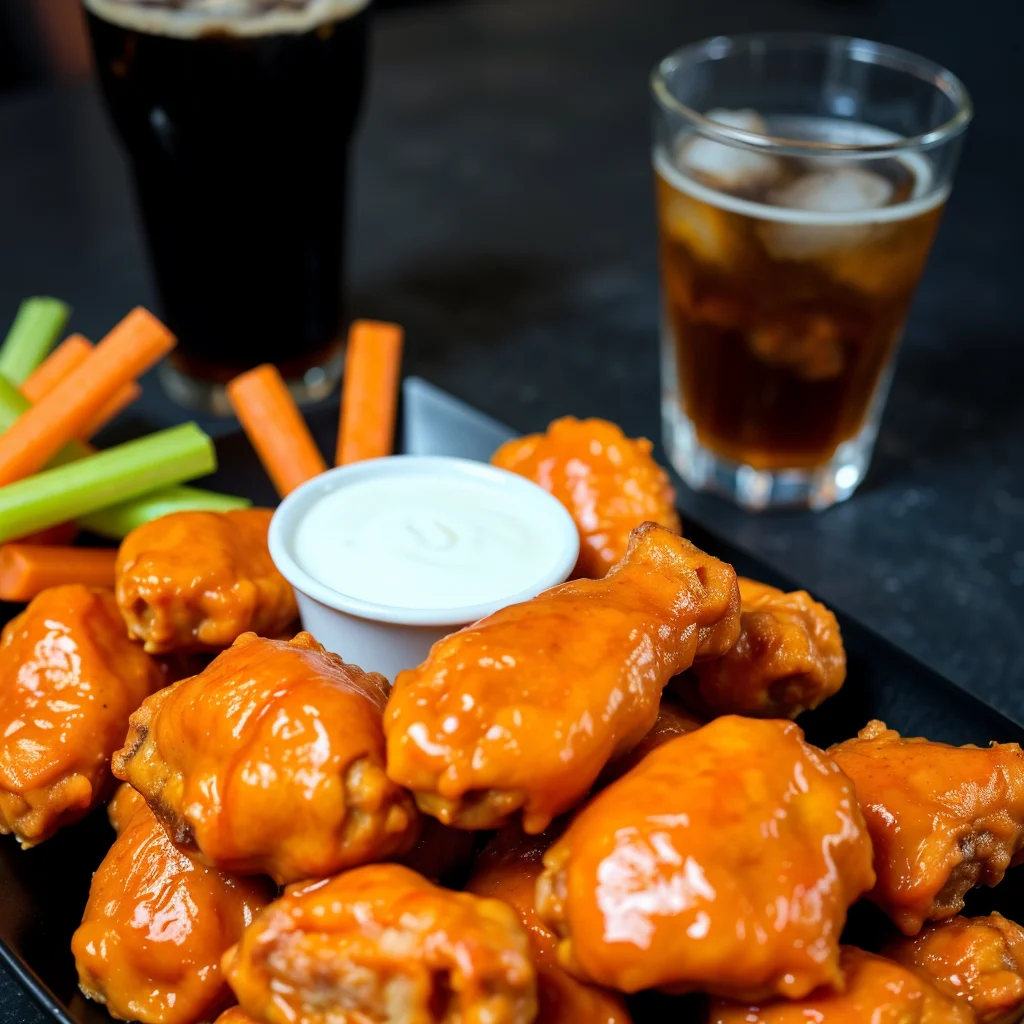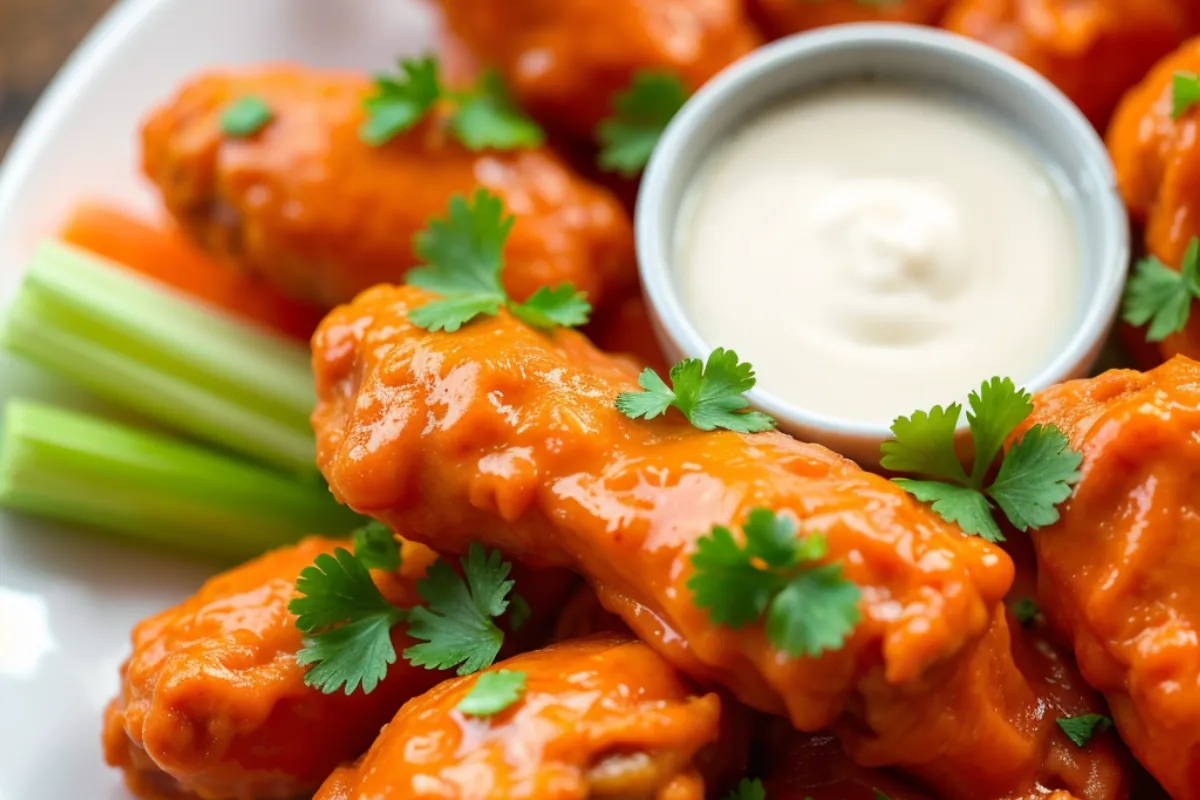Buffalo chicken is a staple in American cuisine, known for its fiery kick and tantalizing flavors. Whether you’ve enjoyed it in the form of wings at a game-day gathering or as a topping on a pizza, there’s no denying the popularity of this dish. But what exactly goes into making chicken wings so irresistible? Let’s dive into the origins and essential ingredients that give buffalo chicken its distinct taste.
Origin of Buffalo Chicken
The story of buffalo chicken starts in the 1960s in Buffalo, New York. The now-famous dish originated at the Anchor Bar, where co-owner Teressa Bellissimo first served buffalo wings to her customers. These wings, tossed in a mixture of hot sauce and butter, quickly became a sensation, leading to the creation of what we now know as buffalo chicken. Over the decades, this humble dish has evolved and spread across the country, becoming a beloved snack at sports bars, parties, and even fine dining establishments.
The History of Buffalo Wings provides a deeper dive into how this dish became a cultural phenomenon.
Main Ingredients of Buffalo Chicken
So, what exactly goes into making buffalo chicken? The ingredients are surprisingly simple but perfectly balanced to create that iconic flavor. Let’s break them down.
Chicken
At the heart of buffalo chicken is, of course, the chicken itself. While wings are the most traditional cut used, many recipes call for chicken breasts, tenders, or even thighs. The key is to use high-quality chicken that can stand up to the bold flavors of the sauce. Whether you choose to bake, fry, or grill, the chicken should be cooked to perfection—crispy on the outside and juicy on the inside.
Hot Sauce
The signature heat in buffalo chicken comes from the hot sauce. The most traditional choice is Frank’s RedHot, known for its balance of heat and flavor. However, there are many brands and homemade recipes that can be used to customize the level of spiciness. The hot sauce is the backbone of the buffalo sauce, giving it that unmistakable kick. If you’re curious about why buffalo chicken is spicy, you can learn more about it here.
Butter
Butter plays a crucial role in buffalo sauce, adding richness and balancing the heat of the hot sauce. When combined with the hot sauce, butter creates a creamy, cohesive sauce that clings perfectly to the chicken. The amount of butter used can vary depending on personal preference and desired richness.
Vinegar and Other Seasonings
To round out the flavor, a touch of vinegar is often added to the buffalo sauce. This acidic component enhances the overall taste, cutting through the richness of the butter. Additional seasonings like garlic powder, onion powder, and paprika are also common, providing depth and complexity to the sauce.
Variations in Buffalo Chicken Recipes

While the traditional recipe is cherished by many, buffalo chicken has seen countless variations over the years. These adaptations allow for different spice levels, health considerations, and creative twists on the classic dish.
Mild vs. Hot Buffalo Chicken
One of the most significant variations in buffalo chicken is the spice level. While some people crave the fiery heat of a traditional buffalo sauce, others prefer a milder version. Adjusting the ratio of hot sauce to butter or opting for a milder hot sauce brand can easily tone down the spiciness without sacrificing flavor.
Healthier Buffalo Chicken Options
Health-conscious eaters can still enjoy buffalo chicken by opting for baked instead of fried chicken. Baking the chicken significantly reduces the fat content while still achieving a crispy texture. Additionally, using low-fat or dairy-free butter alternatives can make the dish lighter without losing its signature taste. For those following a specific diet, such as keto or gluten-free, there are even more modifications available.
Creative Buffalo Chicken Variations
Beyond the traditional wing, buffalo chicken has found its way into a variety of dishes, each offering a unique take on the classic flavor. Here are some popular variations:
- Buffalo Chicken Dip: A creamy, cheesy dip that’s perfect for parties.
- Buffalo Chicken Pizza: Spicy chicken paired with mozzarella and blue cheese on a crispy crust.
- Buffalo Chicken Sandwich: A hearty sandwich featuring buffalo chicken, lettuce, and a drizzle of ranch or blue cheese dressing. For a quick and tasty option, consider making a spicy chicken wrap—you can find a great recipe here.
- Buffalo Chicken Tacos: Soft tacos filled with shredded buffalo chicken, topped with fresh veggies and a tangy dressing.
These creative adaptations allow you to enjoy the flavors of buffalo chicken in new and exciting ways, whether you’re hosting a gathering or just cooking a weeknight dinner.
How Buffalo Chicken is Made: Step-by-Step Guide
Now that we’ve explored the ingredients that make up buffalo chicken, let’s move on to how it’s made. Whether you’re a seasoned cook or trying your hand at this dish for the first time, this step-by-step guide will walk you through the process of making buffalo chicken from scratch.
Preparing the Chicken
The first step in making buffalo chicken is preparing the chicken itself. Here’s how to get it just right:
- Marinating and Seasoning: Start by seasoning your chicken with salt, pepper, and other preferred spices. Some people like to marinate the chicken in buttermilk or a mixture of hot sauce and garlic powder for a few hours. This helps to tenderize the meat and infuse it with flavor before cooking.
- Cooking the Chicken: Depending on your preference, you can bake, fry, or grill the chicken. If frying, use a neutral oil like vegetable oil and fry until the chicken is golden and crispy. For a healthier option, bake the chicken in a preheated oven at 400°F until it reaches an internal temperature of 165°F, ensuring it’s both juicy and cooked through.
Making the Buffalo Sauce
The buffalo sauce is what sets this dish apart, and making it is simpler than you might think. Follow these steps:
- Traditional Preparation Methods: In a small saucepan, melt butter over low heat. Once melted, add your hot sauce of choice (such as Frank’s RedHot) and stir until well combined. Add a splash of vinegar and any additional seasonings like garlic powder or cayenne pepper to taste. The goal is to create a smooth, cohesive sauce that balances heat and flavor.
- Sauce Customization Tips: If you prefer a milder sauce, reduce the amount of hot sauce and increase the butter. For a spicier kick, add more hot sauce or a dash of cayenne pepper. You can also try a sweet and spicy twist by using a honey-based hot sauce—find a great recipe here. Some people like to mix in a tablespoon of honey or brown sugar to add a touch of sweetness, balancing out the heat.
Combining Chicken and Sauce
Now comes the fun part—coating the chicken in that delicious buffalo sauce:
- Techniques for Coating Chicken: Place your cooked chicken in a large bowl and pour the buffalo sauce over it. Toss the chicken pieces until they are evenly coated. Ensure every bite packs flavor by thoroughly covering each piece.
- Ensuring Even Flavor Distribution: If you’re making a large batch, it might be easier to coat the chicken in batches. This way, every piece gets its fair share of sauce. Once coated, serve immediately to enjoy the chicken at its peak flavor and texture.
Serving Buffalo Chicken
How you serve Buffalo wings can enhance the overall experience. Whether you’re hosting a party or enjoying a casual meal, here are some ideas:
- Traditional Serving Methods: The classic way to serve buffalo chicken is with a side of celery sticks and either blue cheese or ranch dressing. The crisp, cool celery provides a refreshing contrast to the spicy chicken, while the creamy dressing helps cool down the heat.
- Popular Side Dishes: Along with celery and dressing, other popular sides include carrot sticks, fries, or a simple green salad. If you’re looking to make the meal heartier, consider serving buffalo chicken alongside mac and cheese or coleslaw. Not sure what to pair with it? Check out some side ideas here that work perfectly with chicken dishes.
- Presentation Tips for Parties and Gatherings: For a party, arrange the chicken on a large platter with the sides neatly placed around it. Garnish with chopped parsley or green onions for a touch of color. Serving the chicken on a bed of lettuce leaves can also add a nice visual appeal.
Pairing Buffalo Chicken with Drinks

The heat of buffalo chicken can be intense, so choosing the right drink is essential to balance the flavors:
- Best Drinks to Complement the Heat: Beer is the classic pairing, with lagers and IPAs being popular choices. The carbonation and crispness of beer help to refresh the palate between bites. If you’re not a beer drinker, consider pairing buffalo chicken with a cold soda or a glass of iced tea.
- Non-Alcoholic Options: Lemonade, sparkling water, or a fruit-infused iced tea can also complement the spicy flavors without overpowering them. For a fun twist, try serving a spicy margarita or bloody mary to echo the heat of the dish.
Health Considerations and Nutritional Information
While Spicy chicken is undeniably tasty, it’s important to consider the nutritional aspects, especially if you’re watching your diet:
- Caloric Content and Nutritional Breakdown: Traditional buffalo wings, when fried and covered in a buttery sauce, can be high in calories, fat, and sodium. For those concerned about the nutritional impact, opting for baked wings and reducing the amount of butter in the sauce can make a significant difference.
- Nutritional Facts for Buffalo Chicken: For a detailed breakdown, refer to Nutrition Facts for Buffalo Chicken, where you can find specific information on calories, fat content, and more.
Common Dietary Modifications
If you have dietary restrictions or preferences, there are plenty of ways to modify Buffalo wings to suit your needs:
- Gluten-Free Options: Use gluten-free flour or breadcrumbs for breading the chicken, and ensure your hot sauce is gluten-free.
- Keto-Friendly Options: Skip the breading and fry the chicken wings directly, or bake them for a low-carb alternative. Most buffalo sauces are keto-friendly, especially when you make them at home.
- Vegan and Vegetarian Alternatives: For those avoiding meat, there are excellent plant-based alternatives like cauliflower or tofu that can be tossed in buffalo sauce. Simply roast or fry the cauliflower florets or tofu cubes, then coat them in the sauce as you would with chicken.
The Cultural Impact of Buffalo Chicken
Spicy Chicken has become more than just a dish; it’s a cultural icon in American food. Often associated with sports events, especially football, buffalo wings are a must-have at Super Bowl parties and other gatherings. The dish’s popularity has grown beyond sports, finding its way into mainstream restaurants and even fine dining. It’s a testament to how something as simple as chicken wings, hot sauce, and butter can become a nationwide phenomenon.
FAQs
What kind of chicken is used for Buffalo wings?
Traditional buffalo wings are made from chicken wings, specifically the drumette and wingette sections. However, you can use other cuts like chicken breasts or tenders for different variations.
Is Buffalo sauce always spicy?
Buffalo sauce is typically spicy, but the heat level can be adjusted. By varying the amount of hot sauce or choosing a milder brand, you can create a sauce that suits your taste.
Can you make spicy chicken without butter?
Yes, you can substitute butter with margarine, olive oil, or a dairy-free alternative if you’re looking to reduce the fat content or avoid dairy.
What’s the difference between Buffalo sauce and hot sauce?
Hot sauce is a simple blend of chili peppers, vinegar, and salt. Buffalo sauce, on the other hand, is hot sauce mixed with butter, giving it a richer, creamier texture.
How do you store and reheat Buffalo chicken?
Store leftover spicy chicken in an airtight container in the refrigerator for up to 3 days. To reheat, bake the chicken in a preheated oven at 350°F until warmed through. Avoid microwaving as it can make the chicken soggy.
Conclusion
Buffalo chicken is a delicious and versatile dish that continues to be a favorite across the United States. Whether you’re sticking to the traditional wings or experimenting with creative variations, understanding what goes into this dish and how to make it is the first step to mastering it at home. With this guide, you’re well on your way to enjoying your very own buffalo chicken, perfectly customized to your taste.

